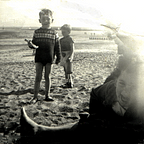The first Beatle in America
Five months before the Ed Sullivan a Beatle pitches up in Benton
“America has everything, why should they want us?” George Harrison, 1964
America was always Oz for all four Beatles, the world they aspired to. It was the backdrop to the films they watched, the magazines they read and the songs they listened to. On one level impossibly remote — none of them had any prospect of visiting before they became successful — it was nonetheless ever present in their imaginative lives.
In 1963 a route to the promise land opened. The storming of the British charts converted them from an impoverished club band to national stars. One target had been reached meaning their bigger goal was a step nearer. “We have one aim: to conquer the United States,” as Harrison put it.
Such claims were initially greeted with derision. The Beatles singles had been released in the US but these had not charted. This was generally the case with British artists, even very successful ones like Cliff Richard. The relationship was essentially asymmetric: America produced rock ‘n roll and the British teenagers bought it.
That was the deal. Or so it seemed.
With Britain was on the cusp of Beatlemania, George Harrison suddenly gained an unlikely US connection. His elder sister, Louise, who had married a mining engineer and emigrated 1956, had recently settled in the rural midwest. When in September 1963, The Beatles were allowed a brief holiday break in an impossibly busy schedule, George took the chance to fly out to see his sister, taking his brother, Peter, and a large shopping bag with him.
Louise Harrison lived in Benton (pop 7,000) ‘in the countryside in Illinois’ and some way from the centres of the record industry. Nonetheless it had radio station and well stocked record stores. George, already relatively flush with Beatles cash, filled his boots as the British say, with records only available on expensive import in England.
I bought Booker T and the MGs’ first album, Green Onions, and I bought some Bobby Bland, all kind of things.
The family reunion occurred under replica of Lindbergh’s Spirit of St. Louis on the day that She Loves You was released in the US. Though the song was already number one in the UK, 99.99% of Americans had not heard of Mr Harrison or the horse rode in on.
Louise had been doing energetic promotional work on behalf of the brother she had not seen since he was twelve. Now and she took George to the local radio station WFRX-AM in West Frankfort. The DJ Marcia Raubach seems to have been more impressed by George’s demeanour than his music. “He was unusual looking…{and} dressed differently ….very soft-spoken and polite.” But she did play their copy of She Loves You.
George was impressed by his sister’s suburban bungalow and spent several hours playing with his niece and nephew and the family dog. In the evening he was entranced by waitresses on roller skates in a local diner
A local band called The Four Vests were playing a birthday party at the Bocce Ball Club in Benton. Louise persuaded them to allow her brother, wearing a dark suit, white shirt and no tie, to sit in. Details of the set are hazy but it apparently included Roll Over Beethoven and Hank Williams numbers. This would be the first live performance of any Beatle in the USA.
Members of the band later took him to a Mt. Vernon, Illinois music shop where George bought a red Rickenbacker 420 guitar. George wanted it to be re-finished in black, which the store-owner did for him. British Beatles fans would be introduced to the instrument October 4 on TV’s Ready Steady Go, the day after George and his brother returned to London.
On that first visit, the twenty-year old Harrison could wander around middle America unmolested. It was in effect the last weekend of what had been a youth curtailed by the slog of being in a band from the age of fourteen. The hours he spent pleasurably flicking through records and jamming with local bands were the calm before the hurricane of Beatlemania. He could even stroll around New York and St Louis unrecognised, a luxury he would never have again.
Five months later George flew back to the USA with his bandmates. Large crowds of screaming girls saw him off at Heathrow and welcomed him at the recently renamed Kennedy International Airport. They remained ever present throughout their short promotional tour as The Beatles entered 40% of American households, from coast to coast and sea to sea.
In February 1964, The Beatles ‘conquered’ the hearts and minds of the country they loved. This conquest would come at a price.
Louise Harrison (1932–2023) RIP
